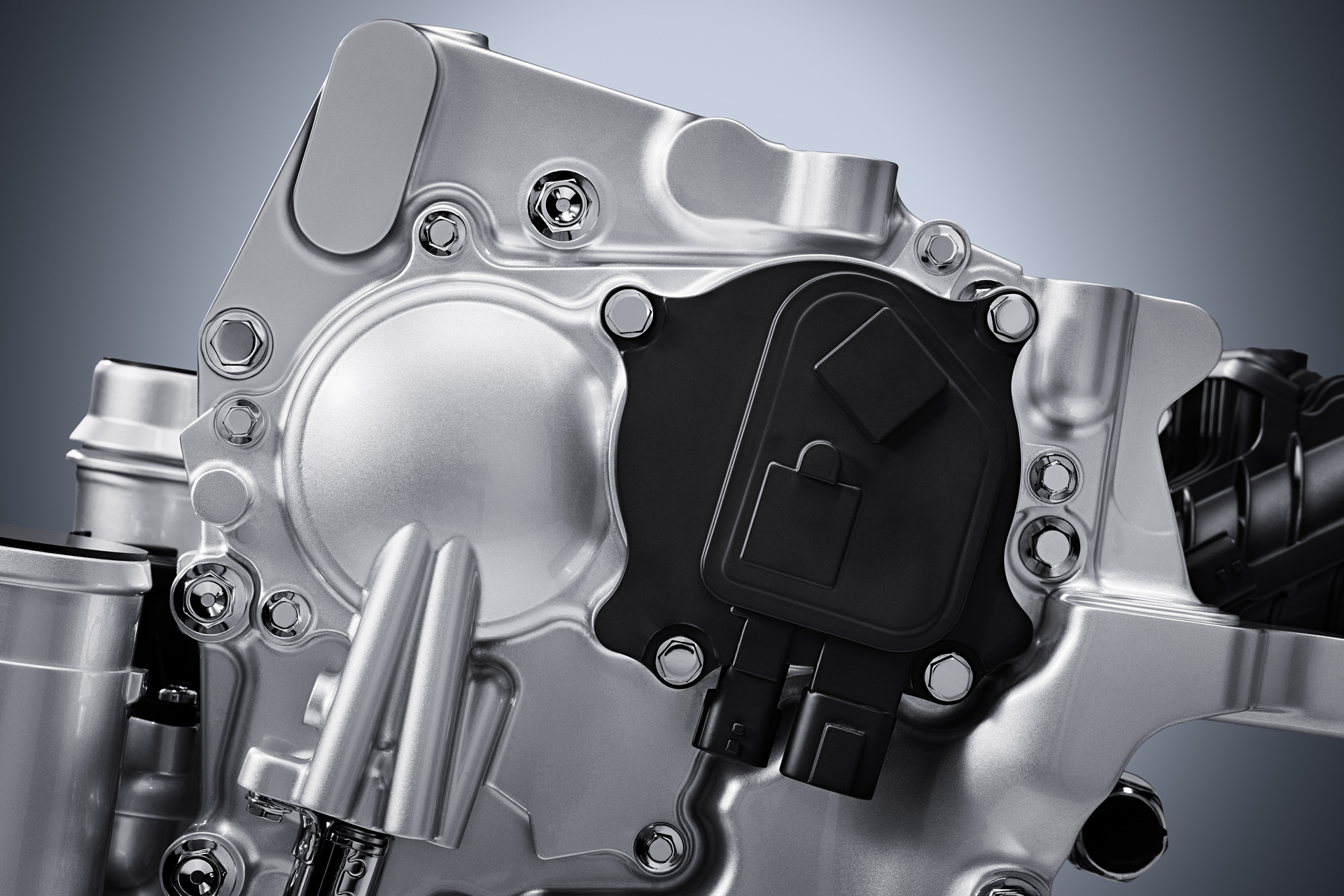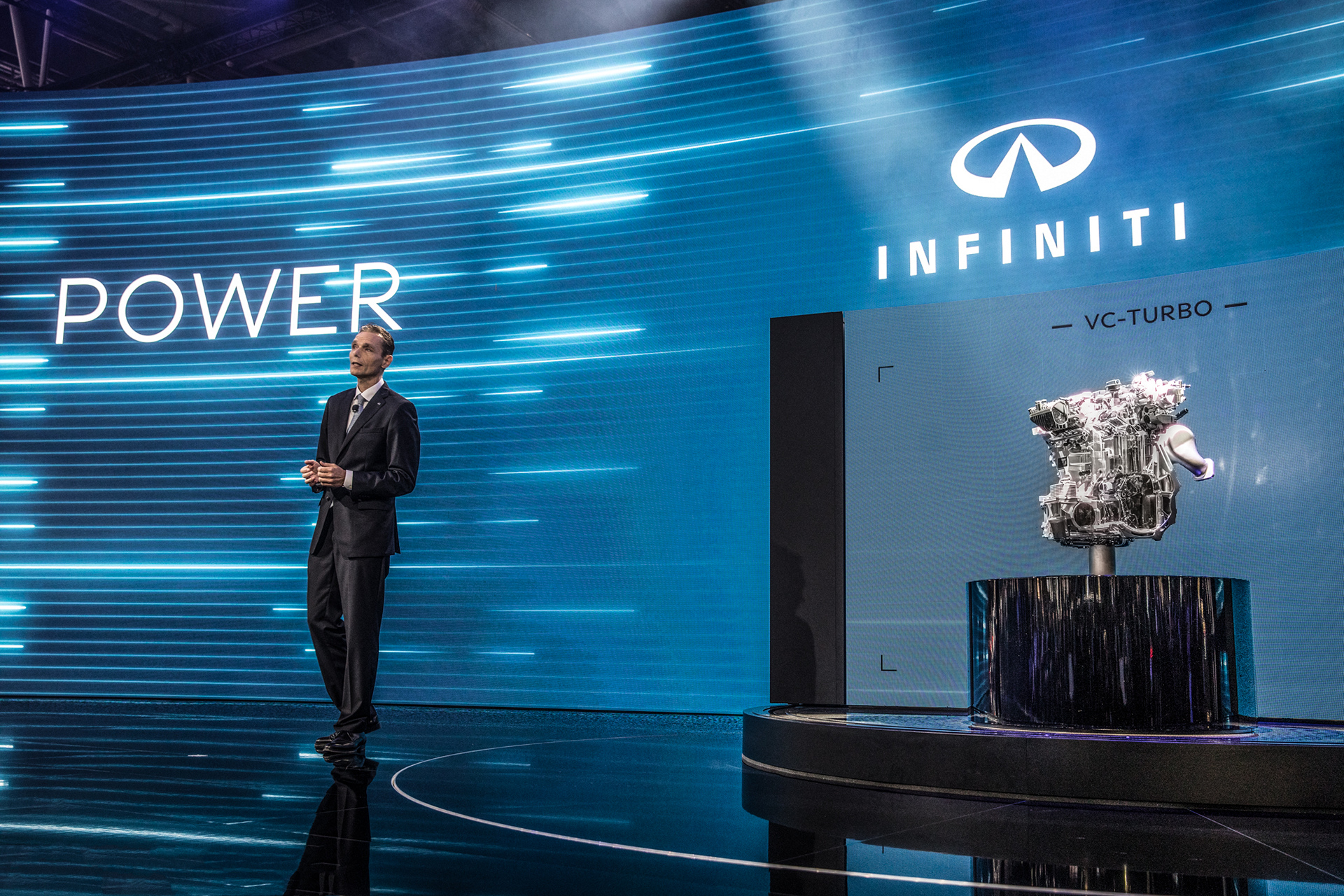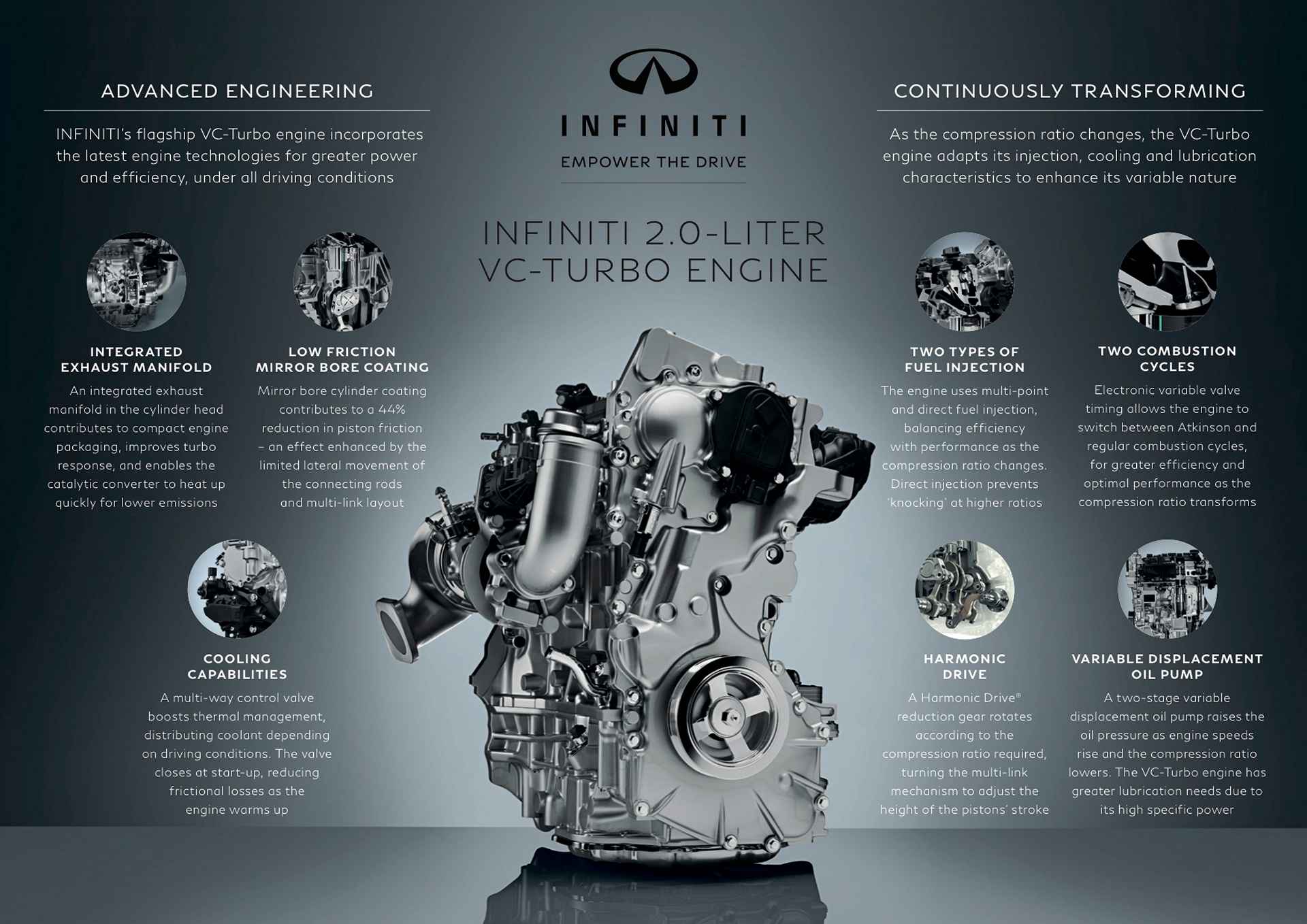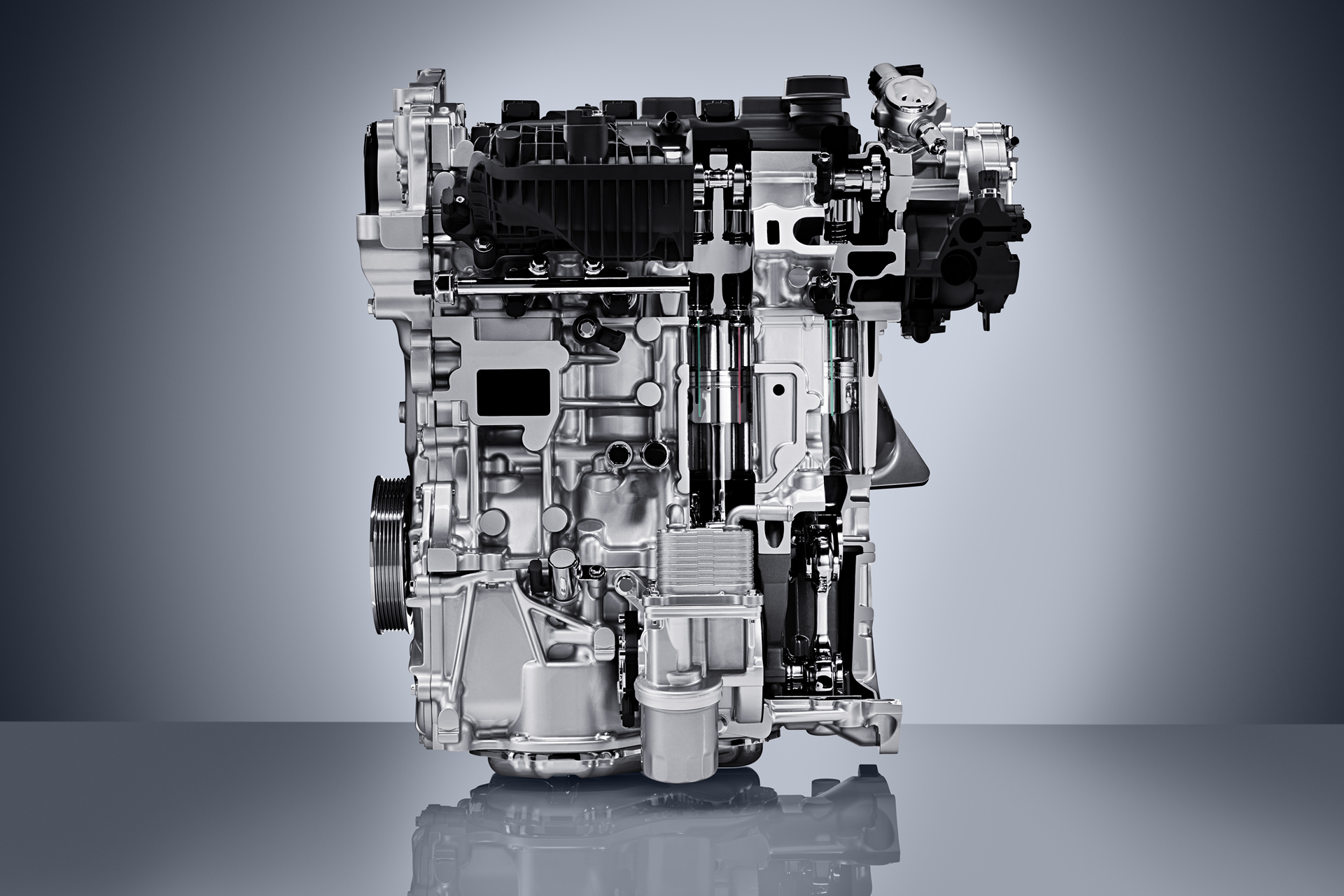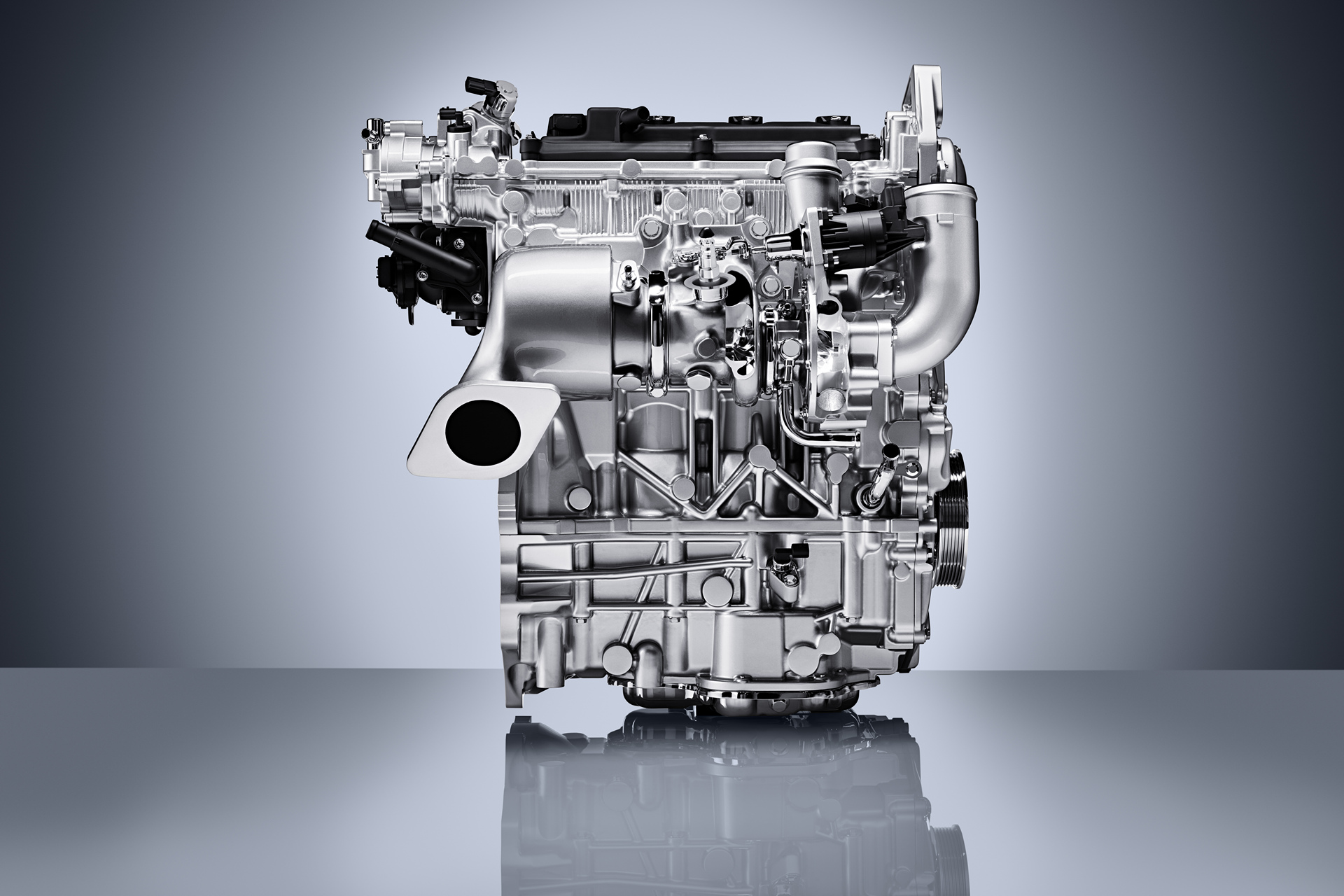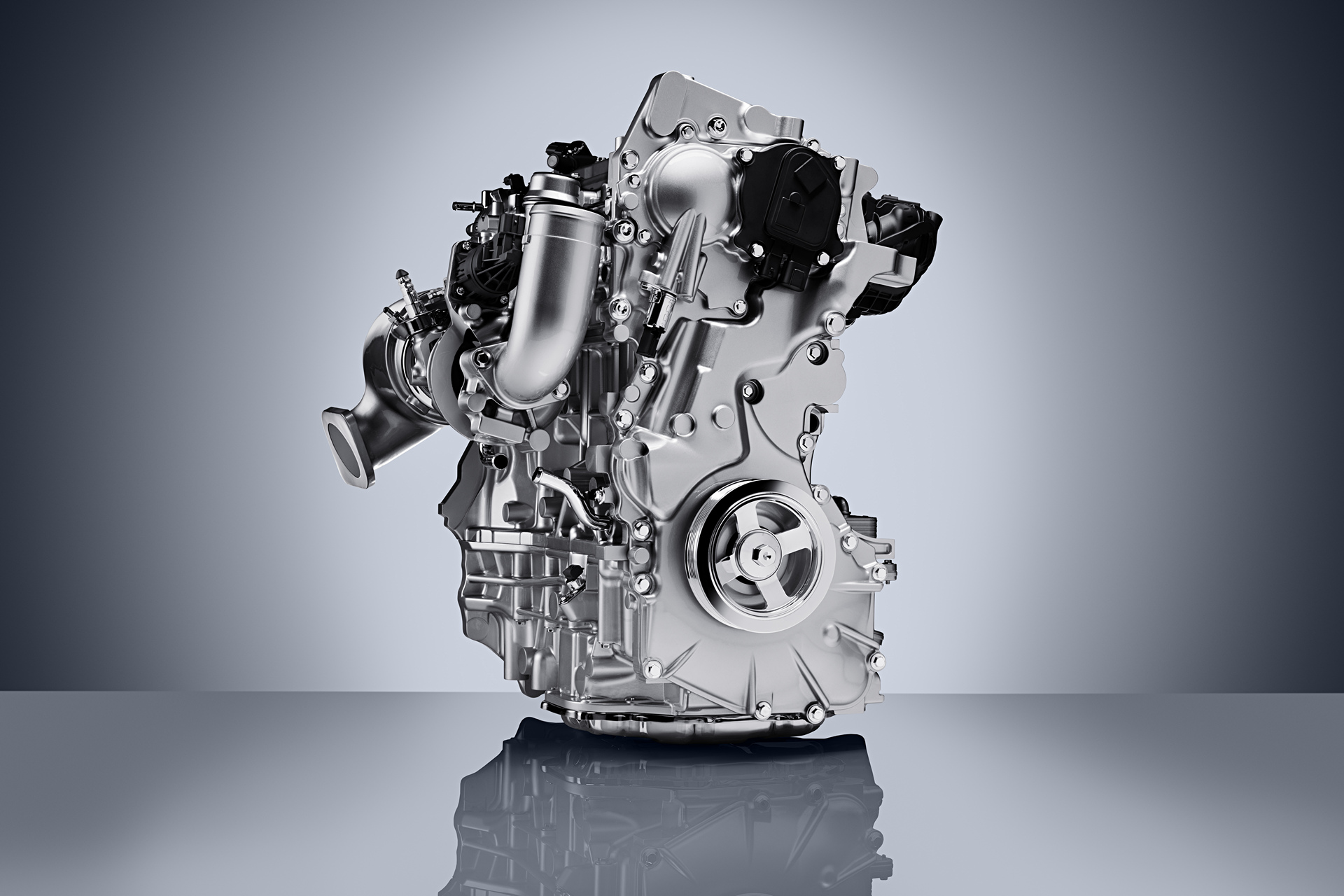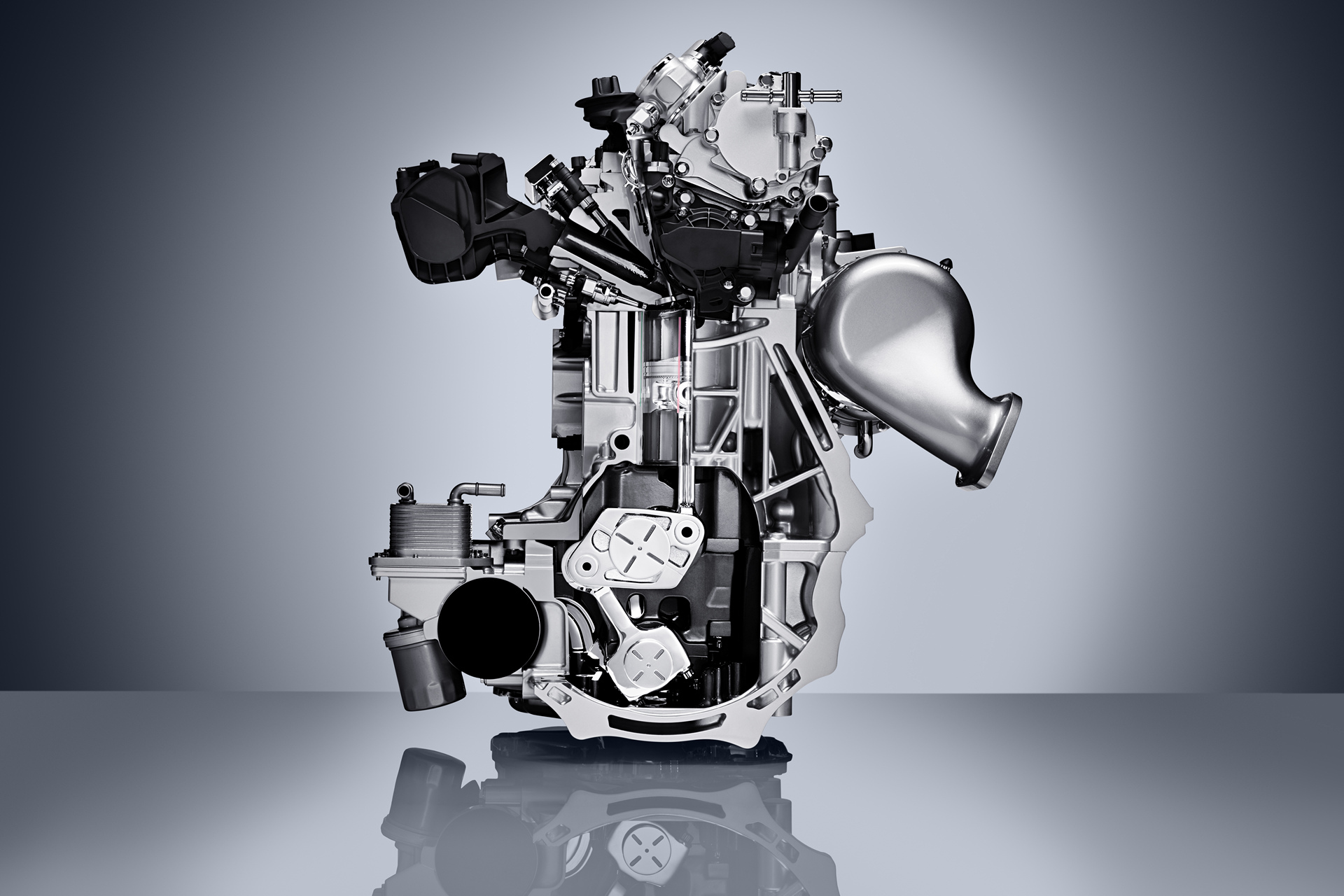INFINITI today unveils the all-new 2.0-liter VC-Turbo (Variable Compression Turbo) gasoline engine, the world’s first production-ready variable compression ratio engine. Shown for the first time at the 2016 Mondial de l’Automobile in Paris, the four-cylinder VC-Turbo promises to be one of the most advanced internal combustion engines ever created.
With the ability to continuously transform, INFINITI’s VC-Turbo technology uses an advanced multi-link system to seamlessly raise or lower the stroke of the pistons, detecting the car’s driving condition and driver inputs, and instantly selecting the most suitable compression ratio.
The engine is able to offer any compression ratio between 8:1 (typical for high performance engines) and 14:1 (used by many manufacturers for high efficiency).
The result is an engine that combines the power of a high-performance 2.0-liter turbo gasoline engine with the torque and efficiency of an advanced diesel powertrain – without the equivalent emissions – offering a compelling alternative to similarly-powered four-cylinder diesel engines. The VC-Turbo engine will be comparable to certain six-cylinder gasoline powertrains for performance, while significantly outperforming them in efficiency.
The four-cylinder VC-Turbo engine achieves lower levels of noise and vibration than conventional internal combustion engines, particularly diesel, and is lighter and more compact than V6 units with comparable power outputs.
INFINITI’s VC-Turbo technology marks a significant leap forward for the internal combustion engine, joining other renowned powertrain innovations such as liquid-cooling, fuel injection, catalytic convertors, and turbocharging. The arrival of the variable compression ratio engine will establish new benchmarks for power, efficiency and emissions.
“Vehicle engineers believe that a breakthrough in internal combustion technology would come from mastering the variable compression ratio. INFINITI will be the first to bring this technology to the market in 2018. This new generation of powertrains will help our global growth and expansion of the INFINITI product portfolio.”
Roland Krueger, President of INFINITI
The world’s first production-ready variable compression ratio engine
- Two decades in development, and on-sale in 2018
- Technology enhances future prospects for the gasoline engine
Fixed compression ratio engines have been in existence throughout the 130-year history of the motor car. Throughout this time, other manufacturers have taken on the challenge of developing a variable compression ratio engine. INFINITI will be the first to bring the technology to market, with an engine that continuously transforms according to driver behavior.
A truly historic challenge, INFINITI has worked on this technology for more than 20 years. The first major breakthrough was the invention by INFINITI of a new multi-link technology in 1998, which held the key to a true variable compression ratio.
INFINITI has tested and developed more than 100 engine prototypes in perfecting the technology, covering over three million kilometers of equivalent road testing and spending over 30,000 hours on the test bed (equal to five million kilometers of on-road testing). The engine is now in its final stages of development on real roads.
The advanced new VC-Turbo engine is the latest driver-focused technology from INFINITI. The company has introduced a series of world-first technologies since 1989, such as ‘steer-by-wire’ Direct Adaptive Steering and predictive forward collision warning.
Understanding compression ratios – fixed vs. variable
- Higher compression ratios offer greater efficiency; lower ratios enable greater performance
- Variable compression provides both power and efficiency within one engine for greater flexibility
- VC-Turbo can shift to any compression ratio between 8:1 and 14:1
The compression ratio is the ratio of the combustion chamber’s volume from its greatest capacity (when the piston is at bottom-dead-center within the cylinder) – to its smallest capacity (when the piston is at top-dead-center).
A higher compression ratio is able to achieve greater efficiency and improved fuel consumption; lower compression ratios offer greater power and torque, particularly in turbocharged engines, but are known for reduced fuel efficiency.
Until now, in every production engine ever built, this ratio has been fixed as a result of the dimensions, components and engine layout.
INFINITI’s VC-Turbo engine uses an advanced multi-link system to change the compression ratio seamlessly, actively raising or lowering the height of the pistons’ stroke. Offering any compression ratio between 8:1 and 14:1, the VC-Turbo engine offers both power and efficiency within the same engine.
As well as offering the benefits of true flexibility, VC-Turbo technology negates the downsides posed by fixed compression. INFINITI’s engine neatly sidesteps the problem of ‘knocking’, a process of inefficiency which can occur in higher compression ratio engines when the air-fuel mixture combusts prematurely in the cylinder, potentially resulting in damage to the engine. INFINITI’s VC-Turbo engine avoids this with direct injection fuel delivery, and by constantly optimizing the compression ratio. This latter characteristic ensures greater efficiency than many high performance engines with a fixed, low compression ratio.
High performance, high efficiency
- INFINITI engineers targeting 27% greater fuel efficiency over similarly-powered V6 gasoline engines
- Dramatic reduction in harmful emissions compared to diesel
- Development teams targeting 200 kW power output with 390 Nm torque
Due to the advantages of the engine’s variable compression ratio, as well as the multitude of other innovations applied to the four-cylinder VC-Turbo engine, INFINITI engineers are targeting up to a 27% improvement in fuel efficiency over V6 engines of a similar power output, depending on its vehicle application.
In addition, gasoline VC-Turbo technology offers a dramatic reduction in emissions over diesel powertrains, such as particulate matter and NOx.
Development teams behind the VC-Turbo engine are targeting a power output of around 200 kW (268 bhp, 272 ps), and approximately 390 Nm torque. This impressive specific power output is higher than many four-cylinder turbocharged gasoline engines. In terms of performance, the 2.0-liter VC-Turbo engine will offer similar performance to some gasoline V6 powertrains, and with the potential for greater fuel efficiency.
VC-Turbo: a driver-focused powertrain
- Compression ratio adapts according to driving conditions and driver inputs
- Wide-range, single-scroll turbocharger for instant acceleration
- Engine able to transform instantaneously, offering maximum efficiency and immediate acceleration
“INFINITI has created an engine that adapts to conditions, and empowers drivers with the engine they want, when they want it. This is the world’s first truly driver-focused powertrain.” Shinichi Kiga, Chief Powertrain Engineer, Gasoline Engine Project Group
INFINITI seeks to deliver empowering performance in everything the company creates, and the new VC-Turbo engine is no exception. Variable compression ratio technology provides drivers with an engine that makes an intelligent choice between performance and efficiency.
The engine moves seamlessly between compression ratios, detecting the car’s driving condition and driver inputs, and instantly selecting the most suitable compression ratio.
Under hard acceleration or heavier engine loads – for instance, when overtaking another vehicle or driving up a hill – the engine shifts to a lower compression ratio. This results in higher performance from the engine, offering a compression ratio that can be compared with the highest-performing turbocharged 2.0-liter four-cylinder engines to appear in a production vehicle.
At steady highway speeds, under slowing driving conditions, at idle, and at low speeds in stop-start traffic, the engine defaults to a higher compression ratio to maximize efficiency.
A wide-range single-scroll turbocharger provides seamless access to the engine’s power and torque reserves and enables immediate acceleration. Combined with a unique ability to vary its compression ratio according to driver behavior, INFINITI’s 2.0-liter VC-Turbo engine delivers the maximum possible efficiency in all conditions, with exhilarating performance just a throttle-opening away.
Revolutionary multi-link technology
- More than 300 technologies patented
- Multi-link technology raises and lowers the piston height seamlessly to vary the compression ratio
- New engine produces a third of the vibrations of a conventional four-in-line engine, and requires no balance shafts
- VC-Turbo switches between Atkinson and regular combustion cycles
“The VC-Turbo engine represents a new breed of engine which can transform continuously, and will establish new benchmarks for future internal combustion engines.” Shinichi Kiga, Chief Powertrain Engineer, Gasoline Engine Project Group
INFINITI has patented more than 300 new technologies specifically designed for application in the new four-cylinder VC-Turbo engine. Among these is the world’s first multi-link system and an electric motor actuator with Harmonic Drive® reduction gear, which together enable the engine to transform its compression ratio continuously.
INFINITI has created an electric motor, connected to the Harmonic Drive® reduction gear with a connecting control arm. The Harmonic Drive® rotates according to the compression ratio required, which then rotates the control shaft at the base of the engine and, in turn, moves the multi-link mechanism. Changing the multi-link angle adjusts the height of the top-dead-center of the pistons, varying the compression ratio. An eccentric control shaft varies the piston stroke position for all four cylinders at the same time.
The layout of the multi-link mechanism makes the VC-Turbo engine smoother than conventional in-line engines, boasting low noise and vibrations levels similar to those of a V6 engine. The multi-link system means the piston connecting rods are almost vertical during the combustion cycle, rather than moving wider laterally as in a traditional crankshaft rotation.
In addition, the multi-link design operates the ideal reciprocating motion when compared with the traditional connecting rod and crankshaft system. The smooth-running VC-Turbo therefore benefits from uncommonly low levels of vibration and does not require any balance shafts. Conventional four-cylinder engines require a pair of balance shafts to reduce second-order vibrations.
INFINITI benchmarked the 2.0-liter VC-Turbo’s vibration characteristics against other four-cylinder turbocharged engines. In the VC-Turbo, engine vibration noise was reduced from a benchmark average of approximately 30 dB to just 10 dB. Such a low level of vibration makes the VC-Turbo four-cylinder engine almost as smooth and refined as a V6. INFINITI’s benchmark V6 engine for the latter stages of VC-Turbo development – the manufacturer’s 3.5-liter ‘VQ’ engine – produces 3 dB of vibration noise, only slightly lower than the new engine.
With a variable compression ratio, the VC-Turbo engine is able to switch between both Atkinson and regular combustion cycles, without interruption. Each cycle enables greater combustion efficiency and optimal engine performance as the combustion ratio transforms.
Under the Atkinson combustion cycle, air intake overlaps with the compression cycle in the cylinder, allowing combustion gas to expand to a larger volume for greater efficiency. The VC-Turbo engine employs the Atkinson cycle under higher compression ratios, where the stroke of the pistons is longer. The modern Atkinson cycle – employed in many advanced hybrid engines – allows the intake valves to be open for a short time as the compression stroke starts.
As the compression ratio lowers, to enable greater engine performance, the engine is able to operate a regular combustion cycle: intake, compression, combustion, and exhaust, each stage taking place in distinct, separate phases, resulting in greater performance.
Renault Sport Formula 1 expertise
- Renault Sport Formula 1 involved in latter-stage testing
- Advanced analysis by Formula 1 engineers ensures durability
INFINITI’s partnership with the Renault Sport Formula 1 team has proved instrumental in accelerating the VC-Turbo’s prototype testing in the latter stages of its development program.
As part of the natural development process for the engine, testing of earlier prototypes saw INFINITI addressing the challenge of component material development and durability.
One such instance revolved around the engine’s bearings. Thanks to its advanced multi-link system, the VC-Turbo engine features around three times as many bearings as a conventional internal combustion engine. VC-Turbo engineers identified a small bearing vibration which manifested at the highest engine speeds under certain conditions.
INFINITI’s VC-Turbo project engineers worked with the Renault Sport Formula 1 team to identify and isolate the vibration, using the team’s expertise in dynamic motion analysis in conditions of up to 20,000 rpm – far higher than any production engine. The team’s experience in movement behavior, and the use of bearing technology in a Formula 1 application, provided valuable insight into developing the engine. This stage of testing has confirmed the durability of the VC-Turbo engine under particularly challenging conditions.
Flagship engine with INFINITI’s latest engine technologies
- VC-Turbo employs both direct and multi-point injection
- Single-scroll turbocharger and integrated exhaust manifold
- Mirror bore coating technology reduces piston friction
The flagship VC-Turbo engine has been engineered to accommodate the latest of INFINITI’s production engine technologies in order to realize – and enhance – its variable nature.
The gasoline VC-Turbo engine employs a combination of both multi-point injection (MPI) and direct injection (DIG), further improving the engine’s ability to balance efficiency and power in all driving conditions. The DIG system improves combustion efficiency and performance due to the heat-absorbing effect of fuel vaporization – which aids cylinder cooling – and allows the engine to avoid ‘knocking’ at higher compression ratios. MPI allows for earlier mixing of air and fuel to increase engine efficiency at low loads. Like the compression ratio, the engine can switch instantly between GDI or MPI at regular engine speeds, while both sets of injectors work in conjunction under a combination of high engine speeds and load.
While the VC-Turbo engine’s multi-link system limits the lateral movement of the connecting rods within the engine – a cause of piston friction – INFINITI’s ‘mirror bore coating’ technology further reduces cylinder friction by 44%. Mirror bore coating technology is a process in which the cylinder walls are sprayed by a special plasma jet. The coating is then hardened and honed, resulting in an ultra-smooth cylinder wall to allow the engine to rotate more smoothly. Mirror bore coating technology has recently been used in INFINITI’s new VR30DDT 3.0-liter V6 twin-turbo engine.
As the engine shifts to allow greater performance or efficiency, a wide-range, single-scroll turbocharger works in conjunction with the VC-Turbo system to maximize acceleration response at any engine speed or compression ratio. For instance, if the driver is cruising at a steady speed but needs to accelerate to overtake, the turbocharger reacts instantly to boost acceleration as the engine shifts seamlessly to a lower compression ratio. The turbocharger enables the four-cylinder VC-Turbo engine to benefit from greater efficiency than a larger, naturally-aspirated six-cylinder engine, yet ensures equivalent performance. The single-scroll turbocharger improves the loss of thermal energy and exhaust pressure, and keeps weight and cost low.
An integrated exhaust manifold is built into the engine’s aluminum cylinder head to further improve packaging, performance and efficiency. The compact size and neater packaging of the cylinder head enables engineers to position the catalytic converter next to the turbo. This reduces the length of the flow path for hot exhaust gases, allowing the catalytic converter to heat up quickly and start the emissions control process sooner. The close proximity to the turbo facilitates the VC-Turbo engine’s immediate accelerative responses.
An electronically-controlled wastegate actuator maintains boost pressure by closely controlling the flow of exhaust gases through the turbocharger. This ensures fuel efficiency and performance under all conditions, even as the compression ratio and engine speeds change.
As the turbocharger recirculates hot exhaust gases back into the engine, the VC-Turbo’s high capacity intercooler lowers the temperature – and therefore the density – of the air, further enhancing the efficiency of the forced induction system.
The four-cylinder VC-Turbo’s high specific power results in greater lubrication and cooling requirements than conventional four-cylinder turbo engines. Development teams addressed this with a two-stage variable displacement oil pump, which enables low-pressure oil distribution at engine speeds below 3,000 rpm. The engine automatically increases oil flow pressure as engine speeds or loads rise (and the compression ratio lowers), ensuring optimum running temperatures at all times.
A multi-way flow control valve (MCV) provides further thermal management. The MCV optimizes the distribution of coolant to the radiator, cabin heater, and oil cooler depending on current conditions and compression ratio. The MCV’s ‘zero flow’ coolant flow mode cuts coolant distribution during a cold start to reduce frictional loses while the engine warms up.
Innovative engineering delivers efficient packaging
- Weight-saving measures contribute to a 25 kg reduction over earlier INFINITI V6 engines
- Advanced multi-link layout ensures efficient packaging in relation to other four-cylinder in-line engines
INFINITI’s downsized 2.0-liter VC-Turbo engine benefits from more compact packaging and weight-saving measures compared with the company’s award-winning 3.5-liter ‘VQ’ V6 engine.
The new engine’s block and cylinder are made from lightweight aluminum alloys, with the multi-link components manufactured in a high-carbon steel alloy. Compared to the ‘VQ’ V6 engine, the VC-Turbo engine weighs 25 kg less, and occupies a smaller engine bay footprint.
In addition to its downsized nature compared to the larger, naturally-aspirated V6, the layout and design contributes to improved packaging and weight savings throughout the powertrain.
The cylinder head with integrated exhaust manifold is compact in size and enables more intelligent integration with the turbocharger and catalytic converter. Cast in aluminum, the cylinder head and manifold union contributes to the engine’s overall reduction in weight. The mirror bore cylinder coating technology also negates the need for cast iron cylinder liners.
With the multi-link system’s minimal lateral movement, development teams were able to do away with the pair of balance shafts that conventional four-cylinder engines require in order to minimize vibrations. With efficient packaging of its new multi-link components, the VC-Turbo engine will therefore occupy a similar space under the bonnet in relation to other four-cylinder in-line engines.
VC-Turbo will drive INFINITI’s next stage of growth
- Innovative powertrains will drive INFINITI’s global expansion
- INFINITI offers a compelling alternative to diesel during a period of global scrutiny into powertrain emissions
- Year-on-year global sales increase of 16% in 2016
“In future, new INFINITI products will benefit from the application of downsized, high-efficiency engines, such as VC-Turbo, which do not compromise performance. INFINITI’s progressive customer base is receptive to new technology, and the VC-Turbo engine is designed to meet this desire to buy innovative products.” Roland Krueger, President of INFINITI
Innovative powertrains such as the VC-Turbo engine will drive INFINITI’s global growth ambitions, and sustain the ongoing expansion of its product portfolio. With VC-Turbo technology, INFINITI has enhanced the prospects of the very idea of the gasoline engine, at a time when the sustainability of diesel combustion is under question.
Significant powertrain innovations will drive INFINITI’s next phase of growth. The new 2.0-liter VC-Turbo engine is the latest – and most momentous – of these innovations. INFINITI has improved corporate average fuel economy by 36% from 2005 to 2014, and future powertrain innovations will see the company improve efficiency further.
INFINITI continues to lay strong foundations for the continued growth of the company in every market around the world. New products have formed the basis of INFINITI’s recent sales momentum. The company sold a record 215,249 vehicles globally in 2015 – a year-on-year rise of 16%. INFINITI sold over 110,000 vehicles during the first half of 2016, a 7% year-on-year rise and another sales record for the company.
Technical specifications – INFINITI ‘MR20 DDT’ 2.0-liter VC-Turbo
| Fuel type | Gasoline |
|---|---|
| Construction | Aluminum block with arc-sprayed mirror coating to cylinder bores, aluminum cylinder head with integrated exhaust manifold, single-scroll turbo with intercooler |
| Compression ratio | 8.0:1 ~ 14.0:1 |
| Capacity | 2.0-liters, 1,997 ~ 1,970 cc (8.0:1 ~ 14.0:1) |
| Bore x Stroke | 84.0 x 94.1 |
| Cylinders | 4 |
| Valves | 16 (four per cylinder) |
| Valve control | Intake: Electronic Variable Valve Timing Control |
| Turbo | Single-scroll turbocharger with electronic wastegate actuator |
| Turbo cooling | Intercooler |
| Fuel system | Gasoline direct injection (DIG) and/or multi-point injection (MPI) |
| Max power | 200 kW (268 hp / 272 ps)* |
| Max torque | 390 Nm (288 lb ft)* |


